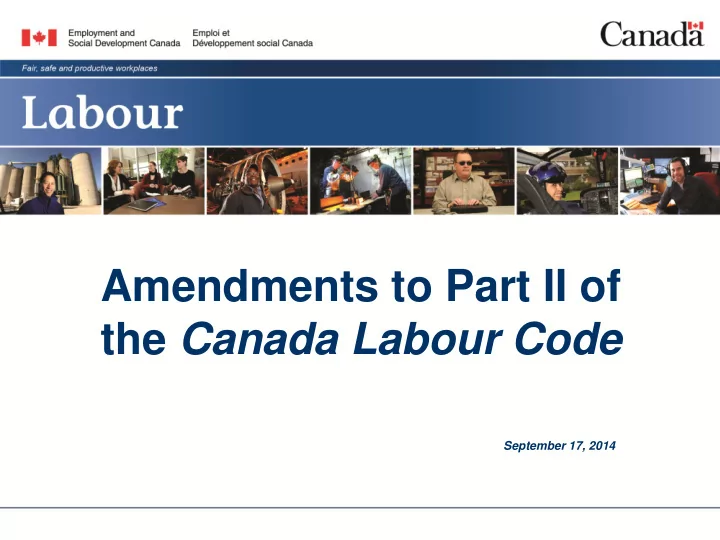

Amendments to Part II of the Canada Labour Code September 17, 2014
Background • Amendments were made to Part II of the Canada Labour Code under the Economic Action Plan 2013 Act, No. 2 . – Royal Assent was received in December 2013. – The amendments will to come into force on October 31, 2014. • The objective of the amendments is to strengthen the internal responsibility system by placing workplace parties at the forefront of resolving occupational health and safety issues. 2
Overview of the Amendments • The definition of “danger” has been simplified and made clearer. • The work refusal process has been redesigned to: – Ensure that meaningful internal mechanisms are used to resolve the situation; – Allow for the dismissal of trivial, frivolous or vexatious matters, as well as continued refusals to work that are made in bad faith or matters that could be dealt with through other legislation; and – Allow for the grouping of work refusals which concern the same employer and issue. • The options available to a Labour Program official conducting a Refusal to Work investigation have been modified to allow for the possibility of an investigation without visiting the workplace (e.g., electronically or by telephone). • Vesting the Minister of Labour with all powers, duties and functions, which will, in turn, be delegated as appropriate to health and safety officers and other officials. 3
Definition of “Danger” • The objective of this amendment is to clarify the definition of danger. • New definition of danger: – “danger” means any hazard, condition or activity that could reasonably be expected to be an imminent or serious threat to the life or health of a person exposed to it before the hazard or condition can be corrected or the activity altered • The new definition will continue to provide protection from all hazards - whether the impact is imminent, such as fall protection, or will materialize over the longer-term, such as an occupational illness. 4
Refusal to Work Process • The refusal to work process has been updated to reinforce the internal responsibility system, which is the cornerstone of Part II of the Canada Labour Code . • The new process requires two internal investigations to take place at the work place: the first investigation by the employer; and where required, a second conducted by the work place health and safety committee or health and safety representative. The employee may participate in both investigations. 5
Refusal to Work – Building on the Internal Responsibility System • The first step of the process still requires employees who believe they are exposed to a danger to inform their employer of their refusal to work. • The employer will then be required to proceed with an investigation, in the presence of the employee and prepare a written report. • Should the issue not be resolved after the employer’s investigation, the work place health and safety committee or the health and safety representative, as the case may be, will conduct an independent investigation and prepare a written report. 6
Employer’s Decision • If there is no resolution following the 2 investigations, the employer will render one of the following decisions: 1. that a danger exists and take immediate action; or, 2. that although a danger exists, the refusal is not permitted because: the refusal puts the life, health or safety of another person directly in danger; or, the danger is a normal condition of work; or, 3. that a danger does not exist. • If the employee disagrees with the employer’s decision, the employer will be required to notify the regulator and provide the written reports from the investigations. • The right to refuse to work continues to apply until the issue is resolved. 7
Determination of the Regulator • Upon being informed of the continued refusal to work, a delegated official will investigate, unless it is determined that: 1. the matter could be more effectively dealt with under another Act; 2. the matter is trivial, frivolous, vexatious; or, 3. the continued refusal is made in bad faith. • Should there be a disagreement as to the determination regarding the application of any of the exceptions, either the employee or the employer can make an application for judicial review under the Federal Courts Act . 8
Investigation by the Regulator • A delegated official will carry out an investigation, if it is required, into the matter. – Investigations may be carried out remotely (i.e., electronically or by telephone). • After completion of the investigation, one of three decisions will be rendered: 1. that a danger exists - and take immediate action; or, 2. that although a danger exists, the refusal is not permitted because: the refusal puts the life, health or safety of another person directly in danger; or the danger is a normal condition of work; or, 3. that a danger does not exist. • When either party disagrees with the determination of whether or not there is danger, they may submit an appeal to the Occupational Health and Safety Tribunal for review and decision. 9
Grouping Work Refusals • The amended legislation allows for the grouping of work refusals with respect to the same employer and that involve substantially the same issues. – May take into account the findings of previous investigations to make a decision as to whether danger exists; – May combine investigations and issue a single decision with respect to that matter for that employer. 10
Authority of Minister to Delegate Powers • In order to ensure greater oversight and accountability for the enforcement of Part II of the Canada Labour Code , the Minister of Labour will now have authority to delegate powers, duties and functions. 11
Recommend
More recommend